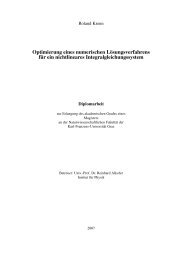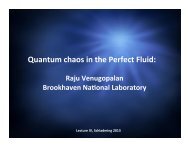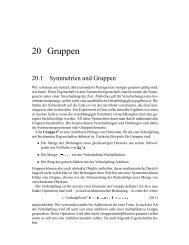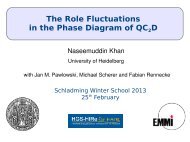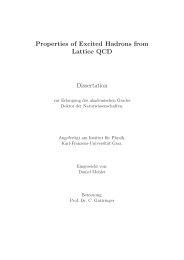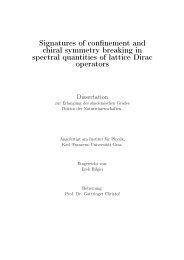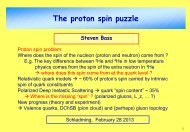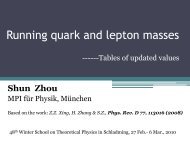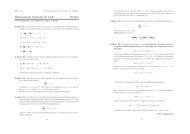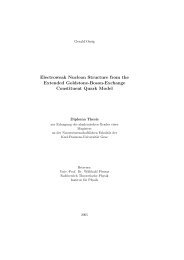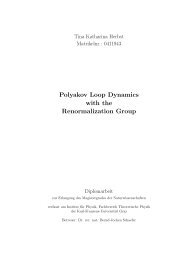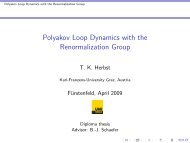The QCD Quark Propagator in Coulomb Gauge and - Institut für Physik
The QCD Quark Propagator in Coulomb Gauge and - Institut für Physik
The QCD Quark Propagator in Coulomb Gauge and - Institut für Physik
You also want an ePaper? Increase the reach of your titles
YUMPU automatically turns print PDFs into web optimized ePapers that Google loves.
62 6.3. Covariant Faddeev equation<br />
It is illum<strong>in</strong>at<strong>in</strong>g to note that u(P) <strong>in</strong> equation(6.19) is a normalised average of ϕ ± so<br />
that, e.g., the proton equation is obta<strong>in</strong>ed by projection on the left with ϕ † +. To illustrate<br />
this we note that equation(6.22) generates an isosp<strong>in</strong> coupl<strong>in</strong>g between u(P) ϕ+ on the<br />
left-h<strong>and</strong>-side (l.h.s.) of equation(6.19) <strong>and</strong>, on the r.h.s.,<br />
√<br />
2 A<br />
+<br />
ν u(P) ϕ − − A 0 ν u(P) ϕ+ . (6.25)<br />
This is just the Clebsch-Gordon coupl<strong>in</strong>g of isosp<strong>in</strong>-1⊕ isosp<strong>in</strong>- 1 to total 2 isosp<strong>in</strong>-1 <strong>and</strong> 2<br />
means that the scalar diquark amplitude <strong>in</strong> the proton, (ud) 0 + u, is coupled to itself <strong>and</strong><br />
the l<strong>in</strong>ear comb<strong>in</strong>ation:<br />
√<br />
2(uu)1 + d − (ud) 1 + u . (6.26)<br />
Similar statements are obviously true of the sp<strong>in</strong> coupl<strong>in</strong>gs.<br />
with<br />
<strong>The</strong> ∆’s Faddeev equation is<br />
∫<br />
D λρ (k; P) u ρ (P) = 4<br />
d 4 l<br />
(2π) 4 M∆ λµ (k, l; P) D µσ(l; P) u σ (P) , (6.27)<br />
M ∆ λµ = t + Γ 1+<br />
σ (k q − l qq /2; l qq ) S T (l qq − k q )t +¯Γ1 +<br />
λ (l q − k qq /2; −k qq ) S(l q ) ∆ 1+<br />
σµ(l qq ). (6.28)<br />
6.3.2 <strong>Propagator</strong>s <strong>and</strong> diquark amplitudes<br />
To complete the Faddeev equations, equations(6.19) <strong>and</strong> (6.27), one must specify the<br />
dressed-quark propagator, the diquark Bethe-Salpeter amplitudes <strong>and</strong> the diquark propagators<br />
that appear <strong>in</strong> the kernels. In contrast to the preced<strong>in</strong>g chapters we use <strong>in</strong> this one<br />
L<strong>and</strong>au gauge.<br />
Dressed-quark propagator<br />
<strong>The</strong> dressed-quark propagator can be obta<strong>in</strong>ed from <strong>QCD</strong>’s gap equation <strong>and</strong> the general<br />
form of the solution is<br />
S(p) = −iγ · p σ V (p 2 ) + σ S (p 2 ) = 1/[iγ · p A(p 2 ) + B(p 2 )] . (6.29)<br />
<strong>The</strong> enhancement of the mass function<br />
M(p 2 ) := B(p2 )<br />
A(p 2 )<br />
(6.30)<br />
is central to the appearance of a constituent-quark mass-scale <strong>and</strong> an existential prerequisite<br />
for Goldstone modes. <strong>The</strong> mass function evolves with <strong>in</strong>creas<strong>in</strong>g p 2 to reproduce



